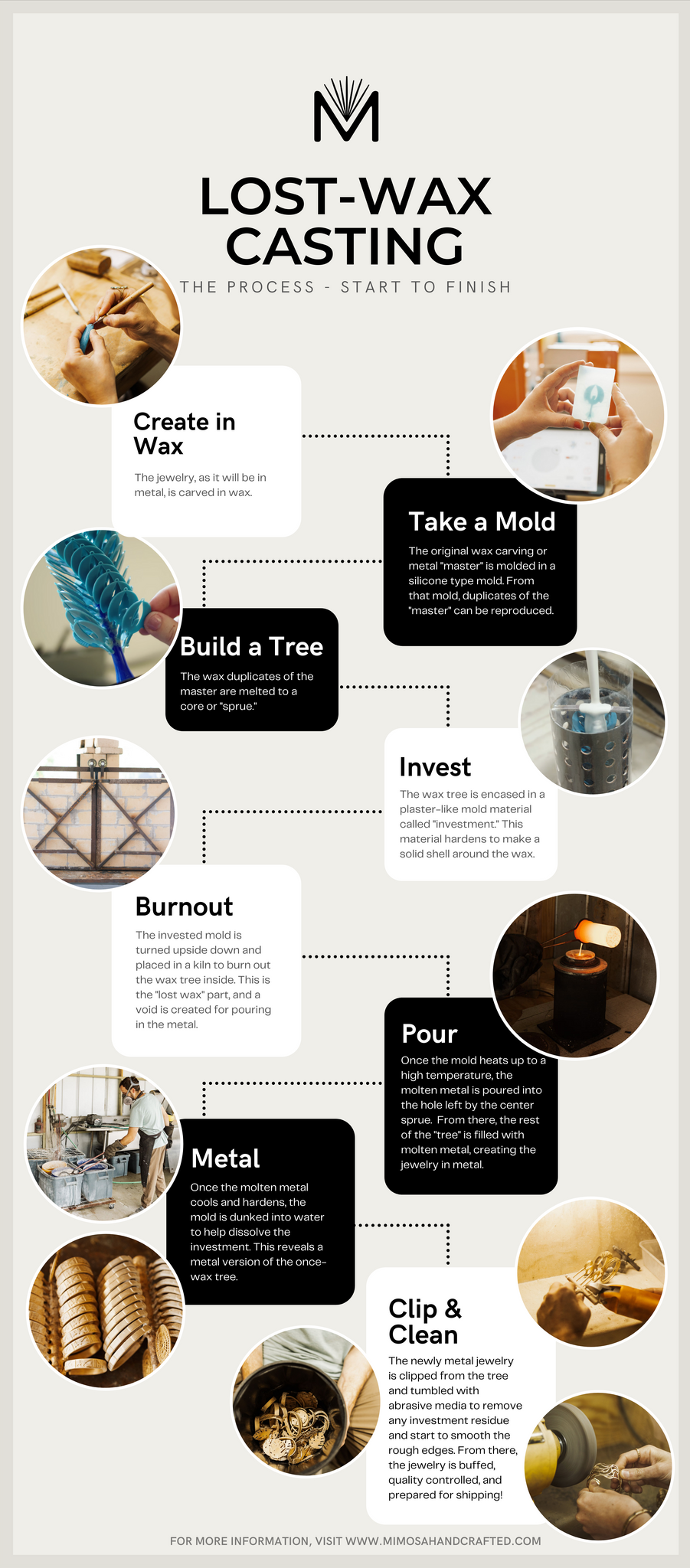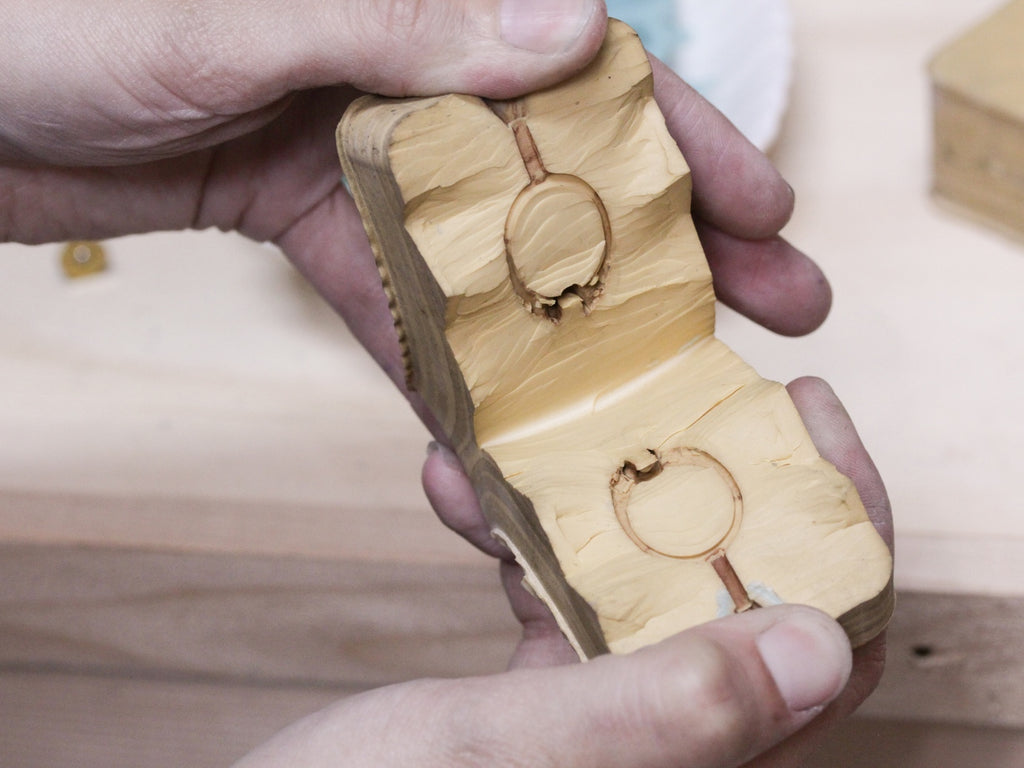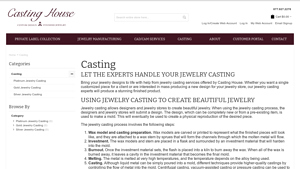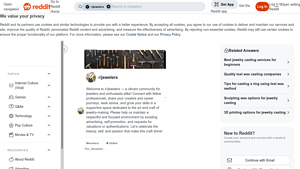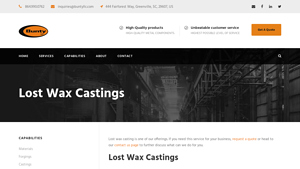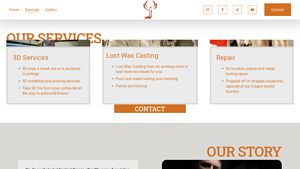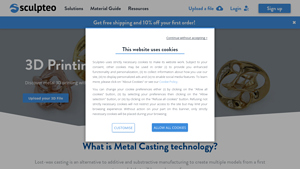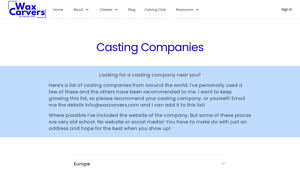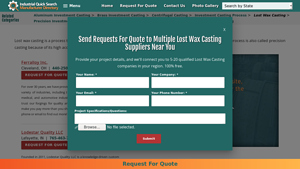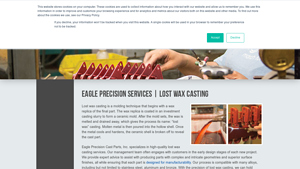Lost Wax Casting Service Guide: Type, Cost, Top List…
Introduction: Navigating the Global Market for lost wax casting service
In the competitive landscape of international manufacturing, sourcing reliable lost wax casting services can pose significant challenges for B2B buyers. The intricacies of this method, which encompasses the creation of detailed metal parts from intricate designs, demand a deep understanding of supplier capabilities and market dynamics. This guide aims to demystify the lost wax casting process by covering a wide range of topics, including various types of casting services, applications across industries, strategies for effective supplier vetting, and insights into cost considerations.
By equipping international B2B buyers, especially those from Africa, South America, the Middle East, and Europe—including key markets like Germany and Saudi Arabia—with comprehensive knowledge, this guide empowers informed purchasing decisions. Buyers will learn how to assess potential partners based on quality, technology, and ethical practices, ensuring their investments yield high-quality products. Furthermore, it addresses the importance of customization and scalability in lost wax casting services, enabling businesses to adapt to changing market demands.
Navigating the global market for lost wax casting services doesn’t have to be daunting. With this guide, buyers can confidently approach their sourcing needs, transforming challenges into opportunities for growth and innovation.
Understanding lost wax casting service Types and Variations
| Type Name | Key Distinguishing Features | Primary B2B Applications | Brief Pros & Cons for Buyers |
|---|---|---|---|
| Traditional Lost Wax Casting | Uses handcrafted wax models; labor-intensive process. | Custom jewelry, art pieces, limited production. | Pros: High detail; unique designs. Cons: Time-consuming; higher costs. |
| 3D Printed Wax Casting | Incorporates 3D printing for wax models. | Rapid prototyping, mass production. | Pros: Faster production; design flexibility. Cons: May require additional finishing. |
| Investment Casting | Involves creating a mold from wax models for metals. | Aerospace, automotive, and industrial components. | Pros: High precision; suitable for complex shapes. Cons: Initial setup costs can be high. |
| Centrifugal Casting | Utilizes centrifugal force to fill molds with metal. | Jewelry, dental applications, and intricate designs. | Pros: Reduces air pockets; enhances detail. Cons: Equipment can be costly; limited to certain designs. |
| Vacuum-Assisted Casting | Employs vacuum to draw metal into the mold. | High-end jewelry, detailed components. | Pros: Exceptional detail; minimizes defects. Cons: Requires specialized equipment; higher operational costs. |
What Are the Characteristics of Traditional Lost Wax Casting?
Traditional lost wax casting is characterized by the use of handcrafted wax models that are meticulously crafted to reflect the desired final product. This technique is labor-intensive, making it suitable for custom jewelry or unique art pieces where high detail is paramount. B2B buyers should consider the longer lead times and higher costs associated with this method, but the resulting pieces often showcase exceptional artistry and individuality.
How Does 3D Printed Wax Casting Enhance Production?
3D printed wax casting integrates modern technology by utilizing 3D printing to create wax models. This approach significantly accelerates the production process, making it ideal for rapid prototyping and mass production. B2B buyers can benefit from the design flexibility offered by this method, allowing for intricate designs that were previously difficult to achieve. However, the final products may require additional finishing work, which should be factored into the overall timeline and costs.
In What Scenarios is Investment Casting Most Effective?
Investment casting is particularly effective in industries such as aerospace and automotive, where high precision and the ability to create complex shapes are essential. This method involves creating a mold from a wax model and is known for its accuracy and quality. While it can entail higher initial setup costs, the long-term benefits of producing durable and precise components make it a worthwhile investment for B2B buyers focused on high-performance applications.
What Are the Advantages of Centrifugal Casting?
Centrifugal casting employs centrifugal force to fill the mold with molten metal, which helps to eliminate air pockets and enhance detail. This method is widely used in jewelry and dental applications, where intricate designs are crucial. B2B buyers appreciate the reduced likelihood of defects and the ability to produce high-quality components. However, the cost of the necessary equipment can be a barrier for some businesses, particularly smaller operations.
How Does Vacuum-Assisted Casting Improve Quality?
Vacuum-assisted casting is a technique that uses vacuum pressure to draw molten metal into the mold, resulting in exceptional detail and minimized defects. This method is particularly favored in high-end jewelry and detailed component manufacturing. B2B buyers should consider the benefits of superior quality and detail, although the need for specialized equipment and potentially higher operational costs must also be taken into account when evaluating this option.
Key Industrial Applications of lost wax casting service
| Industry/Sector | Specific Application of lost wax casting service | Value/Benefit for the Business | Key Sourcing Considerations for this Application |
|---|---|---|---|
| Jewelry Manufacturing | Custom jewelry production, including intricate designs and models | High precision and quality in final products | Need for specialized casting techniques and metal options |
| Aerospace | Production of complex components like turbine blades and housings | Enhanced performance and durability in critical parts | Compliance with strict industry standards and certifications |
| Medical Devices | Manufacturing of surgical instruments and implants | High precision and biocompatibility of materials | Sourcing certified materials and ensuring quality control |
| Automotive | Production of engine components and custom parts | Reduced weight and improved efficiency of vehicles | Consideration of alloy properties and mechanical performance |
| Art and Sculpture | Creation of fine art pieces and sculptures | Ability to replicate detailed artwork with precision | Collaboration with artists for accurate design representation |
How is Lost Wax Casting Service Used in Jewelry Manufacturing?
In the jewelry manufacturing sector, lost wax casting is pivotal for creating custom pieces with intricate designs. This method allows jewelers to replicate fine details from original models, ensuring that each piece is unique and high-quality. International B2B buyers, particularly from regions like Europe and the Middle East, must consider sourcing from companies that offer a wide range of metal options and have expertise in advanced casting techniques to achieve the desired finish and quality.
What Role Does Lost Wax Casting Play in Aerospace Applications?
In aerospace, lost wax casting is utilized for producing complex components such as turbine blades and housings. This process ensures that the parts are not only lightweight but also possess high strength and durability, critical for performance in demanding conditions. Buyers in this sector need to prioritize suppliers who comply with stringent industry standards and can provide detailed certifications to guarantee the reliability of the components.
How is Lost Wax Casting Beneficial for Medical Device Manufacturing?
The medical device industry leverages lost wax casting to produce surgical instruments and implants with exceptional precision. This method allows for the creation of intricate designs necessary for functionality while ensuring biocompatibility of materials used. For international buyers, particularly those in Africa and South America, sourcing from manufacturers with a proven track record in quality control and compliance with medical regulations is essential for success.
What Advantages Does Lost Wax Casting Offer in Automotive Production?
In automotive manufacturing, lost wax casting is employed to create engine components and custom parts that enhance vehicle performance. This casting technique allows for reduced weight without compromising strength, leading to improved fuel efficiency. Buyers must focus on sourcing from suppliers who understand alloy properties and can deliver components that meet the rigorous demands of the automotive industry.
How is Lost Wax Casting Used in Art and Sculpture Creation?
Lost wax casting is extensively used in the art and sculpture sector to replicate fine art pieces with high precision. This process allows artists to bring their intricate designs to life, maintaining the integrity of their original work. Collaborating with casting services that understand the artistic vision is crucial for international buyers, ensuring that the final product meets aesthetic and quality expectations.
3 Common User Pain Points for ‘lost wax casting service’ & Their Solutions
Scenario 1: Inconsistent Quality in Casted Products
The Problem: B2B buyers often face the challenge of inconsistent quality in products produced through lost wax casting. For instance, a jewelry manufacturer in Europe may order a bulk casting of intricate designs, only to receive pieces that vary significantly in detail and finish. This inconsistency can stem from various factors, including the quality of the wax models, the casting process used, or even the handling of materials by the service provider. Such discrepancies not only lead to wasted resources and time but can also damage the buyer’s reputation if the final products fail to meet customer expectations.
The Solution: To mitigate quality issues, B2B buyers should prioritize working with experienced casting service providers that emphasize quality assurance throughout the casting process. Before placing an order, buyers should request samples or prototypes to evaluate the service provider’s craftsmanship. Additionally, it’s crucial to communicate specific quality standards and expectations upfront, such as detailing the desired finish and detailing level. Implementing a quality control checklist based on the casting provider’s processes can further ensure that the final output aligns with the buyer’s standards. Establishing a robust partnership with the casting service, including regular feedback and updates, can also help maintain quality consistency over time.
Scenario 2: Long Lead Times Impacting Production Schedules
The Problem: Timely delivery is a critical concern for B2B buyers, especially those operating in fast-paced markets like jewelry and industrial components. A manufacturer in South America may encounter delays in receiving their lost wax castings, which can disrupt their production schedule and lead to missed deadlines. Such delays can arise from various reasons, including unexpected equipment failures, supply chain disruptions, or simply underestimating the time required for complex designs.
The Solution: To address lead time challenges, B2B buyers should engage in proactive planning and establish clear timelines with their casting service providers. It is advisable to create a detailed project timeline that includes milestones for design approval, prototype casting, and final production. Buyers should also consider implementing a buffer in their schedules to accommodate potential delays. Additionally, sourcing from multiple casting providers can provide flexibility; if one service faces delays, buyers can quickly pivot to another without significant disruptions. Regular communication with the casting service about production schedules can also help anticipate and mitigate potential delays.
Scenario 3: Navigating Complex Design Specifications
The Problem: Many B2B buyers, particularly those new to lost wax casting, struggle with articulating their design specifications accurately. A jewelry designer from the Middle East, for example, might have a unique vision for a piece but may lack the technical know-how to convey the intricate details required for successful casting. Miscommunication can lead to designs that are poorly executed or even uncastable, resulting in frustration and wasted resources.
The Solution: To effectively navigate design complexities, B2B buyers should invest time in developing clear, detailed design documentation before initiating the casting process. Utilizing CAD software to create precise models can significantly enhance the clarity of specifications. Buyers should also seek casting service providers that offer design consultation services. Many experienced providers can assist in refining designs to ensure they are feasible for casting, as well as suggest materials that best suit the intended final product. Establishing an open dialogue with the casting provider during the design phase can help clarify any uncertainties and ensure that the final outcome aligns with the buyer’s vision. Furthermore, requesting a small batch of prototypes before mass production can provide valuable insights into how well the designs translate into physical products.
Strategic Material Selection Guide for lost wax casting service
What Are the Key Materials Used in Lost Wax Casting Services?
Lost wax casting is a highly versatile technique used across various industries, including jewelry, automotive, and aerospace. The choice of material significantly influences the casting process and the final product’s performance. Below, we analyze four common materials used in lost wax casting, focusing on their properties, advantages, disadvantages, and implications for international B2B buyers.
How Does Gold Perform in Lost Wax Casting?
Gold, particularly in its various karat forms (10K, 14K, 18K), is a popular choice for lost wax casting in jewelry. It boasts excellent corrosion resistance and a high melting point (around 1,064°C). Gold’s malleability allows for intricate designs, making it suitable for detailed jewelry pieces.
Pros: Gold’s durability and aesthetic appeal make it highly desirable for luxury items. It also has a strong resale value, which can be advantageous for businesses.
Cons: The primary drawback is its high cost, which can significantly impact the overall project budget. Additionally, the manufacturing complexity increases with the karat level, requiring precise control during the casting process.
Impact on Application: Gold is compatible with various media, including skin, making it ideal for jewelry. However, its high cost may limit its use in mass production.
Considerations for International Buyers: Buyers should ensure compliance with local regulations regarding precious metals and consider standards such as ASTM for quality assurance.
What Are the Benefits of Using Silver in Casting?
Silver, especially sterling silver (92.5% pure), is another common material in lost wax casting. It has a lower melting point than gold (around 961.8°C) and offers excellent ductility and thermal conductivity.
Pros: Silver is more affordable than gold, making it a popular choice for both high-end and mass-produced jewelry. Its antimicrobial properties also make it suitable for various applications beyond jewelry.
Cons: While silver is durable, it is prone to tarnishing, which may require additional finishing processes. The casting process can also introduce imperfections if not managed properly.
Impact on Application: Silver’s compatibility with skin and other materials makes it versatile. However, its tarnishing nature can be a concern for end-users.
Considerations for International Buyers: Buyers should be aware of the varying purity standards across regions, such as the European hallmarking system, to ensure compliance and quality.
Why Choose Brass for Lost Wax Casting?
Brass, an alloy of copper and zinc, is frequently used in lost wax casting for decorative items and hardware. It has a melting point of approximately 900°C and offers good corrosion resistance and machinability.
Pros: Brass is cost-effective and allows for a wide range of finishes, making it ideal for decorative applications. Its strength and durability also make it suitable for functional components.
Cons: Brass can be less durable than precious metals and may require additional coatings to prevent tarnishing. The casting process can also lead to porosity if not managed correctly.
Impact on Application: Brass is compatible with various environments, but its susceptibility to corrosion in harsh conditions can limit its use.
Considerations for International Buyers: Buyers should consider the environmental regulations regarding copper alloys, as they may vary significantly by region, particularly in Europe and North America.
What Are the Advantages of Using Aluminum in Lost Wax Casting?
Aluminum is gaining popularity in lost wax casting due to its lightweight nature and excellent corrosion resistance. With a melting point of around 660°C, it is easier to work with than many other metals.
Pros: Aluminum is lightweight, making it ideal for applications where weight is a concern. It is also cost-effective and can be anodized for additional surface protection.
Cons: While aluminum is strong, it can be less durable than other metals, especially in high-stress applications. The casting process may also require more precise temperature control to avoid defects.
Impact on Application: Aluminum is suitable for various applications, including automotive and aerospace components, but may not be ideal for high-end jewelry.
Considerations for International Buyers: Buyers should ensure compliance with international standards such as ASTM and consider local regulations regarding aluminum alloys.
Summary Table of Material Selection for Lost Wax Casting
| Material | Typical Use Case for lost wax casting service | Key Advantage | Key Disadvantage/Limitation | Relative Cost (Low/Med/High) |
|---|---|---|---|---|
| Gold | High-end jewelry, luxury items | Excellent corrosion resistance | High cost | High |
| Silver | Jewelry, decorative items | More affordable than gold | Prone to tarnishing | Med |
| Brass | Decorative hardware, functional components | Cost-effective and versatile | Less durable than precious metals | Low |
| Aluminum | Automotive parts, lightweight applications | Lightweight and corrosion-resistant | Less durable in high-stress use | Low |
This strategic material selection guide provides valuable insights for international B2B buyers looking to optimize their lost wax casting processes. By understanding the properties and implications of each material, businesses can make informed decisions that align with their production needs and market demands.
In-depth Look: Manufacturing Processes and Quality Assurance for lost wax casting service
What Are the Key Stages in the Manufacturing Process of Lost Wax Casting?
Lost wax casting, also known as investment casting, is a sophisticated manufacturing process widely utilized in jewelry making and various industries for producing intricate metal parts. The process consists of several critical stages, each requiring precision and expertise to ensure high-quality outcomes.
Material Preparation: How Is the Right Wax Model Created?
The first step involves the creation of a wax model that represents the final product. This can be achieved through traditional carving or modern 3D printing techniques, allowing for high levels of detail. The wax model is then attached to a wax stem using sprues, which serve as channels for molten metal flow during casting.
Once the wax model is prepared, it is placed into a flask and surrounded by an investment material, typically a liquid plaster. This mixture hardens to form a mold, capturing every detail of the wax model. The quality of the wax and investment material directly impacts the final casting, making it essential for manufacturers to use industry-standard materials.
What Techniques Are Used in the Forming Stage of Lost Wax Casting?
The forming stage primarily consists of the burnout process, where the wax is melted away to leave a hollow cavity in the investment material. The flasks containing the molds are heated in a high-temperature oven, causing the wax to evaporate. This step is crucial as it prepares the mold for metal casting, ensuring that no wax residue interferes with the final product.
Following the burnout, the metal—whether gold, silver, or platinum—is melted at specific temperatures depending on the alloy. Various techniques, such as centrifugal casting, vacuum-assisted casting, and pressure casting, may be employed to ensure the molten metal fills the mold uniformly. These methods enhance the quality of the casting by minimizing defects and ensuring even distribution of metal.
How Is the Assembly Process Managed After Casting?
Once the metal has cooled and solidified, the castings are removed from the mold through a process called divesting. This may involve breaking the investment material or using chemical methods to dissolve it. After divesting, the sprues are cut off, and the castings undergo a thorough cleaning process to remove any surface imperfections.
The assembly stage may include additional steps such as polishing, plating, or gemstone setting, depending on the specific requirements of the final product. Each of these processes requires meticulous attention to detail to ensure that the jewelry or component meets the desired specifications and quality standards.
What Quality Assurance Measures Are Essential in Lost Wax Casting?
Quality assurance (QA) is a fundamental aspect of the lost wax casting process, ensuring that every product meets international standards and customer expectations. A robust QA system is not only critical for maintaining product integrity but also for building trust with B2B clients.
Which International Standards Should B2B Buyers Be Aware Of?
For international B2B transactions, compliance with recognized standards is crucial. ISO 9001 is one of the most widely adopted quality management systems, providing a framework for consistent quality in manufacturing. Additionally, industry-specific certifications such as CE marking (for products sold in the European Economic Area) or API (American Petroleum Institute) standards for components used in oil and gas applications are important considerations.
B2B buyers should ensure that their suppliers have these certifications, as they reflect a commitment to quality and adherence to industry best practices.
What Are the Key QC Checkpoints in the Manufacturing Process?
Quality control (QC) checkpoints are strategically placed throughout the manufacturing process to identify and rectify issues before they escalate. The three main QC checkpoints include:
-
Incoming Quality Control (IQC): This involves inspecting raw materials and components upon arrival to ensure they meet specified requirements.
-
In-Process Quality Control (IPQC): During manufacturing, various parameters are monitored to maintain quality standards. This includes checking the temperature during melting and ensuring proper mold preparation.
-
Final Quality Control (FQC): After the casting is complete, the final products undergo thorough inspections, including dimensional checks and surface quality assessments. Any defects identified at this stage must be addressed before products are shipped to clients.
How Can B2B Buyers Verify Supplier Quality Control Practices?
B2B buyers must conduct due diligence to verify the quality control practices of their suppliers. This can include:
-
Supplier Audits: Regular audits of suppliers’ facilities help assess compliance with quality standards and identify areas for improvement.
-
Quality Reports: Requesting detailed quality reports, including testing results and defect rates, can provide insights into a supplier’s performance.
-
Third-Party Inspections: Engaging third-party inspection services can offer an impartial assessment of a supplier’s quality control measures.
What Are the Nuances of QC and Certification for International B2B Buyers?
International B2B buyers, especially those from diverse regions such as Africa, South America, the Middle East, and Europe, must navigate various certification requirements and quality expectations. Understanding local regulations and industry standards is essential for ensuring compliance and avoiding costly delays.
Additionally, cultural differences in business practices can impact quality expectations. Therefore, establishing clear communication channels and setting mutual quality standards at the outset of any business relationship is vital.
Conclusion
In summary, the lost wax casting service is a multifaceted process that requires careful attention to detail at every stage, from material preparation to quality assurance. By understanding the manufacturing processes and quality control measures, B2B buyers can make informed decisions when selecting suppliers, ensuring they receive high-quality products that meet their needs and standards.
Practical Sourcing Guide: A Step-by-Step Checklist for ‘lost wax casting service’
Introduction
When sourcing lost wax casting services, it’s essential to approach the process with a structured checklist to ensure you partner with a reliable provider. This guide offers a step-by-step approach tailored for international B2B buyers, particularly in regions like Africa, South America, the Middle East, and Europe. By following these steps, you can secure high-quality casting services that meet your specific needs.
Step 1: Define Your Technical Specifications
Before reaching out to suppliers, clearly outline your technical requirements. This includes the type of metal you wish to use (e.g., gold, silver, platinum) and the complexity of your designs. Defining these specifications helps in identifying suppliers who have the necessary capabilities and experience.
- Consider the desired finish and any post-casting processes you might need, such as polishing or plating.
- Ensure your specifications include tolerances and any industry standards relevant to your product.
Step 2: Conduct Market Research on Suppliers
Take the time to research potential casting service providers thoroughly. Look for companies with a strong reputation in the industry, particularly those that specialize in lost wax casting.
- Utilize online resources, industry directories, and trade shows to identify reputable suppliers.
- Check for customer reviews and testimonials to gauge their reliability and quality of service.
Step 3: Evaluate Potential Suppliers
Before committing, it’s crucial to vet suppliers thoroughly. Request company profiles, case studies, and references from buyers in a similar industry or region. Don’t just rely on their website.
- Look for suppliers that have experience with similar projects and can provide examples of their work.
- Ensure they have a quality assurance process in place to minimize defects in casting.
Step 4: Verify Certifications and Compliance
Ensure that the casting service provider complies with relevant industry standards and certifications. This is particularly important for maintaining quality and environmental responsibility.
- Ask for certifications like ISO 9001 for quality management systems or any specific certifications related to precious metals.
- Verify that they adhere to local and international regulations regarding the materials and processes they use.
Step 5: Request Samples and Prototypes
Before placing a large order, request samples or prototypes of your designs. This step is vital to evaluate the supplier’s craftsmanship and to ensure that they can meet your quality standards.
- Assess the quality of the castings and check for any imperfections or inconsistencies.
- Use this opportunity to gauge their responsiveness and communication skills during the sample process.
Step 6: Negotiate Terms and Conditions
Once you’ve selected a supplier, discuss and negotiate the terms of your partnership. This includes pricing, lead times, payment terms, and any warranties on the work performed.
- Ensure all aspects of the agreement are documented clearly to avoid misunderstandings later on.
- Consider including clauses for handling defects or delays to protect your interests.
Step 7: Establish a Long-Term Relationship
After a successful initial order, consider building a long-term relationship with your chosen supplier. A reliable partner can streamline your production process and help you innovate with new designs.
- Regular communication and feedback can foster a collaborative environment, allowing for continuous improvement.
- Explore opportunities for bulk discounts or exclusive agreements for future projects.
By following this checklist, you can effectively navigate the complexities of sourcing lost wax casting services, ensuring that your business receives the quality and reliability it requires.
Comprehensive Cost and Pricing Analysis for lost wax casting service Sourcing
What Are the Key Cost Components in Lost Wax Casting Services?
When sourcing lost wax casting services, understanding the cost structure is crucial for international B2B buyers. The primary cost components include:
-
Materials: The choice of metals significantly affects costs. Precious metals like gold, platinum, and silver command higher prices, while alloys may offer cost savings. Additionally, the quality of wax or resin used for models influences overall expenses.
-
Labor: Skilled labor is essential for creating high-quality castings. The expertise required for each step of the process—wax model creation, investment, burnout, and casting—impacts labor costs. Labor rates can vary by region, affecting total expenses.
-
Manufacturing Overhead: This includes the costs of maintaining equipment, utilities, and facility operations. High-quality casting firms often invest in advanced technology, which can lead to higher overhead but may result in superior products.
-
Tooling: Depending on the complexity of the design, tooling costs can be significant. Custom molds may be necessary for unique designs, and these require upfront investment.
-
Quality Control (QC): Ensuring that each casting meets specific standards incurs additional costs. A robust QC process is essential, especially for international buyers who may require certifications.
-
Logistics: Shipping costs can vary widely based on the destination and the chosen Incoterms. Buyers should consider not only the transportation fees but also potential customs duties and taxes.
-
Margin: Suppliers will include a profit margin in their pricing, which can vary based on market conditions, demand, and competition.
How Do Pricing Influencers Affect Lost Wax Casting Costs?
Several factors influence the pricing of lost wax casting services:
-
Volume and Minimum Order Quantity (MOQ): Larger orders typically benefit from economies of scale, resulting in lower per-unit costs. Conversely, small orders may incur higher prices due to setup and tooling costs.
-
Specifications and Customization: Highly customized projects require additional time and resources, impacting costs. Buyers should clearly communicate specifications to avoid unexpected expenses.
-
Material Choices: The metal’s market price is volatile and can significantly affect overall costs. Buyers should stay informed about current market trends.
-
Quality and Certifications: High-quality castings that meet specific industry standards or certifications may cost more. Buyers in regulated industries should prioritize suppliers with relevant certifications.
-
Supplier Factors: The supplier’s reputation, experience, and location can influence pricing. Established suppliers may charge a premium for their expertise and reliability.
-
Incoterms: The chosen Incoterms dictate who is responsible for shipping costs and risks, affecting the final price. Buyers should select terms that align with their logistical capabilities.
What Tips Can Help Buyers Negotiate Cost-Efficiency in Lost Wax Casting?
For international B2B buyers, particularly from regions like Africa, South America, the Middle East, and Europe, several strategies can enhance cost-efficiency:
-
Negotiate Pricing: Engage suppliers in discussions about pricing, especially if planning large orders. Building long-term relationships can lead to better terms over time.
-
Consider Total Cost of Ownership: Evaluate not just the upfront costs but also the long-term implications of quality, durability, and potential rework costs. A higher-quality casting may reduce maintenance and replacement expenses.
-
Understand Pricing Nuances: Be aware that pricing can vary based on regional economic conditions. For example, suppliers in Europe may have different pricing structures compared to those in Africa or South America due to labor costs and material availability.
-
Request Multiple Quotes: Comparing quotes from several suppliers can provide insights into market rates and help identify the best value.
-
Be Clear on Requirements: Clearly outline project specifications and expectations to avoid misunderstandings that could lead to increased costs.
Disclaimer on Pricing
Prices for lost wax casting services are subject to fluctuations based on material costs, labor rates, and market demand. It is advisable for buyers to consult directly with suppliers for the most accurate and current pricing tailored to their specific needs.
Alternatives Analysis: Comparing lost wax casting service With Other Solutions
Understanding Alternatives in Casting Solutions
When considering manufacturing processes for jewelry and other intricate designs, it’s essential to explore various casting methods. While lost wax casting is widely recognized for its precision and detail, alternative solutions may offer different advantages that could better suit specific business needs. Here, we compare lost wax casting with two viable alternatives: sand casting and 3D printing.
Comparison Table
| Comparison Aspect | Lost Wax Casting Service | Sand Casting | 3D Printing |
|---|---|---|---|
| Performance | High precision and detail | Moderate precision | High precision, variable depending on technology used |
| Cost | Higher initial investment | Lower material costs | Moderate to high, depending on material and technology |
| Ease of Implementation | Requires skilled labor | Easier, less skilled labor required | Requires design software and 3D printing expertise |
| Maintenance | Moderate; equipment needs regular upkeep | Low; simpler equipment | High; frequent updates in technology and maintenance of printers |
| Best Use Case | Intricate designs and fine jewelry | Large, simple parts or prototypes | Rapid prototyping and complex geometries |
Detailed Breakdown of Alternatives
Sand Casting: What Are Its Pros and Cons?
Sand casting is a traditional method that uses sand to create molds for metal casting. One of its primary advantages is the lower cost of materials and equipment, making it accessible for businesses with tighter budgets. Additionally, sand casting is easier to implement, requiring less specialized skill compared to lost wax casting. However, it generally offers moderate precision and is better suited for larger, simpler parts rather than intricate designs. Thus, while it can be a cost-effective solution, it may not meet the high-quality demands of fine jewelry production.
3D Printing: Is It the Future of Casting?
3D printing is an innovative approach that allows for the creation of complex geometries that might be challenging for traditional casting methods. It offers high precision and customization, which can significantly reduce the time from design to production. However, the costs can vary widely based on the technology used and the materials selected. Additionally, implementing 3D printing requires a solid understanding of design software and the printing process, which may pose a challenge for some businesses. Despite these hurdles, for those focusing on rapid prototyping or unique designs, 3D printing can be a game-changer.
Conclusion: How Can B2B Buyers Choose the Right Solution?
Selecting the ideal casting solution hinges on your specific needs, including the complexity of designs, budget constraints, and production volume. For businesses aiming for high precision and detailed designs, lost wax casting remains a top choice. However, if cost is a primary concern and the designs are less intricate, sand casting could be a viable alternative. On the other hand, if your focus is on rapid innovation and prototyping, exploring 3D printing might be worthwhile. Ultimately, understanding the strengths and limitations of each method will enable B2B buyers to make informed decisions that align with their operational goals and market demands.
Essential Technical Properties and Trade Terminology for lost wax casting service
What Are the Key Technical Properties of Lost Wax Casting Services?
In the realm of lost wax casting, understanding the essential technical properties is crucial for ensuring quality and efficiency in production. Below are critical specifications that B2B buyers should consider:
1. Material Grade
Material grade refers to the specific classification of metals used in the casting process, such as 14K gold, sterling silver (925), or platinum (950). Each grade has unique properties, including durability, malleability, and resistance to tarnish. B2B buyers need to select the appropriate material grade based on the intended use of the final product, as this affects both quality and marketability.
2. Tolerance
Tolerance is the permissible limit of variation in a physical dimension of the casting. For example, a tolerance of ±0.1 mm may be specified for intricate jewelry designs. Tight tolerances are essential for components that require precise fit and function, particularly in high-end applications. Understanding tolerance levels helps buyers evaluate a supplier’s capabilities and ensures that the final product meets their specifications.
3. Surface Finish
Surface finish refers to the texture and appearance of the final casting, which can range from matte to highly polished. The desired surface finish can significantly influence the aesthetic appeal of jewelry pieces. Buyers should communicate their finish requirements clearly, as this will determine the post-casting processes involved, such as polishing or plating.
4. Casting Method
The casting method employed can affect the quality and characteristics of the final product. Common methods include centrifugal casting, vacuum casting, and pressure casting. Each method has its advantages; for instance, vacuum casting is excellent for intricate designs with minimal air pockets. B2B buyers should inquire about the casting methods used by suppliers to ensure they align with their quality standards.
5. Burnout Temperature
Burnout temperature is the specific temperature at which the wax model is melted out of the mold during the casting process. This temperature varies depending on the material used in the wax model. Maintaining the correct burnout temperature is crucial for achieving a clean mold and preventing defects in the final casting. Buyers should confirm that suppliers have the necessary equipment to control this parameter effectively.
What Are Common Trade Terminologies in Lost Wax Casting?
Familiarity with industry jargon can enhance communication and streamline the procurement process. Here are some essential terms:
1. OEM (Original Equipment Manufacturer)
OEM refers to a company that produces parts or equipment that may be marketed by another manufacturer. In lost wax casting, buyers may work with OEMs to produce custom designs that adhere to specific branding or quality standards. Understanding OEM relationships can help buyers leverage expertise in producing complex designs.
2. MOQ (Minimum Order Quantity)
MOQ is the smallest quantity of a product that a supplier is willing to sell. In the context of lost wax casting, MOQs can vary widely based on the complexity of the design and the materials used. B2B buyers must consider MOQs when planning their inventory and production schedules to avoid excess costs or stock shortages.
3. RFQ (Request for Quotation)
An RFQ is a document sent to suppliers requesting a price quote for specific products or services. In lost wax casting, this typically includes detailed specifications such as material grade, dimensions, and quantity. A well-prepared RFQ can lead to more accurate pricing and better supplier responses.
4. Incoterms (International Commercial Terms)
Incoterms are standardized trade terms that define the responsibilities of buyers and sellers in international transactions. They specify who pays for shipping, insurance, and tariffs, which is crucial for B2B transactions involving lost wax casting services. Understanding Incoterms helps buyers mitigate risks and manage costs effectively.
By grasping these technical properties and trade terminologies, B2B buyers can make informed decisions, ensuring that they select the right partners and materials for their lost wax casting needs.
Navigating Market Dynamics and Sourcing Trends in the lost wax casting service Sector
What Are the Key Market Dynamics and Trends Influencing the Lost Wax Casting Service Sector?
The lost wax casting service sector is experiencing a transformative phase, driven by several global market dynamics. One significant factor is the rising demand for customized and intricate designs, particularly in jewelry and art sectors, which has led to an increased reliance on advanced technologies such as CAD/CAM and 3D printing. International B2B buyers are increasingly seeking suppliers who can offer rapid prototyping and flexible production capabilities, allowing for short lead times and quick adjustments to designs. Additionally, the growing trend of personalization in consumer products is pushing manufacturers to adopt more agile and responsive sourcing strategies.
Emerging B2B technologies, such as automated quoting systems and instant pricing tools, are reshaping how buyers engage with suppliers. These innovations streamline the procurement process, enabling quicker decision-making and enhanced transparency in pricing. For buyers from regions like Africa, South America, the Middle East, and Europe, the ability to evaluate costs and timelines efficiently is critical, especially as they navigate fluctuating material costs and global supply chain challenges.
Furthermore, sustainability is becoming a pivotal concern, with buyers increasingly prioritizing suppliers who demonstrate responsible sourcing practices. The focus on minimizing environmental impact and adhering to ethical standards is shaping procurement strategies across industries, making it essential for suppliers to be proactive in communicating their sustainability efforts.
How Is Sustainability and Ethical Sourcing Impacting the Lost Wax Casting Service Sector?
Sustainability and ethical sourcing are no longer optional considerations for B2B buyers in the lost wax casting service sector; they are essential components of the decision-making process. The environmental impact of casting processes, particularly in terms of energy consumption and waste generation, has led to increased scrutiny from stakeholders. Buyers are now demanding transparency regarding the sourcing of materials, especially precious metals, which can have significant ecological footprints if not responsibly managed.
To address these concerns, suppliers are increasingly adopting ‘green’ certifications and utilizing sustainable materials in their casting processes. This includes sourcing recycled metals and implementing energy-efficient practices in their operations. Certifications such as ISO 14001 for environmental management systems are becoming valuable assets for suppliers looking to differentiate themselves in a competitive market. Buyers are encouraged to seek partners who can provide documentation of their sustainable practices, ensuring that their supply chains align with their corporate responsibility goals.
Moreover, the trend towards ethical sourcing is reshaping supplier relationships. Buyers are more inclined to partner with suppliers who prioritize fair labor practices and community engagement, especially in regions where mining and production occur. This shift not only enhances brand reputation but also fosters loyalty among consumers who are increasingly aware of the ethical implications of their purchases.
What Is the Historical Context of Lost Wax Casting Services That B2B Buyers Should Know?
The lost wax casting process, with its origins dating back over 5,000 years, has evolved significantly, impacting modern B2B practices in the sector. Initially used by ancient civilizations for crafting intricate jewelry and religious artifacts, this method has been refined through centuries of technological advancements. The traditional process, which involved hand-carving wax models, has now integrated modern techniques like 3D printing, enabling unprecedented precision and efficiency.
In the contemporary landscape, the lost wax method is not only limited to jewelry but has expanded into various industries, including aerospace, automotive, and art. This evolution reflects a growing recognition of the method’s versatility and its ability to produce complex geometries that are increasingly demanded in today’s market. Understanding this historical context can provide B2B buyers with valuable insights into the capabilities and innovations that suppliers can offer, ultimately guiding them in making informed sourcing decisions.
Frequently Asked Questions (FAQs) for B2B Buyers of lost wax casting service
-
How do I ensure quality when sourcing lost wax casting services internationally?
To ensure quality when sourcing lost wax casting services, start by vetting potential suppliers thoroughly. Look for certifications, such as ISO standards, which indicate adherence to quality management systems. Request samples of their work to assess craftsmanship and material quality. Additionally, review customer testimonials and case studies to gauge their reliability and experience in your industry. Engaging in direct communication with the supplier can also clarify their processes and commitment to quality. -
What factors should I consider when selecting a lost wax casting supplier?
When selecting a lost wax casting supplier, consider their experience in your specific market and product type. Evaluate their technological capabilities, such as the types of metals they can cast and the precision of their machinery. Check their production capacity and lead times to ensure they can meet your demands. Additionally, assess their communication practices and customer service, as these factors will influence the overall partnership experience. -
What are the typical minimum order quantities (MOQs) for lost wax casting services?
Minimum order quantities (MOQs) for lost wax casting services can vary significantly based on the supplier and the complexity of the designs. Many suppliers may require an MOQ ranging from 50 to 100 pieces for standard items, while custom designs might have higher MOQs due to the setup involved in the casting process. It’s essential to discuss your specific needs with potential suppliers to find one that aligns with your production goals and budget. -
What customization options are available for lost wax casting?
Customization options for lost wax casting are extensive and can include design alterations, choice of metal (e.g., gold, silver, platinum), finishes (e.g., polished, matte), and additional features like gemstone settings. Suppliers often offer CAD services to help you visualize your design before casting. Be sure to communicate your specific requirements clearly to the supplier to ensure they can accommodate your customization requests effectively. -
What payment terms should I expect when working with lost wax casting suppliers?
Payment terms for lost wax casting services can vary widely among suppliers. Common practices include upfront deposits ranging from 30% to 50% of the total order value, with the balance due upon completion or delivery. Some suppliers may offer net payment terms, such as net 30 or net 60 days, especially for established clients. It’s crucial to clarify payment terms upfront to avoid misunderstandings and ensure a smooth transaction process. -
How can I manage logistics when importing lost wax castings?
Managing logistics when importing lost wax castings involves several key steps. First, ensure that your supplier is familiar with international shipping regulations and can provide necessary documentation, such as invoices and certificates of origin. Work with a reliable freight forwarder to handle customs clearance and delivery to your location. Additionally, consider shipping insurance to protect your investment during transit. Regular communication with your supplier about shipment timelines and potential delays will help streamline the logistics process. -
What quality assurance measures should be in place for lost wax casting services?
Quality assurance measures for lost wax casting services should include a comprehensive inspection process at various stages of production. This can involve checking the wax models, monitoring the casting process, and conducting final inspections on the finished products. Suppliers should have protocols for identifying and addressing defects, as well as providing documentation of compliance with industry standards. Requesting detailed reports on quality checks can give you confidence in the supplier’s commitment to maintaining high standards. -
How do I handle communication and project management with my lost wax casting supplier?
Effective communication and project management with your lost wax casting supplier are essential for a successful partnership. Establish clear channels of communication from the outset, such as dedicated project managers or regular update meetings. Utilize project management tools to track progress, share files, and set deadlines. Be proactive in addressing any concerns or adjustments to the project to ensure that both parties are aligned throughout the casting process. Regular feedback can foster a collaborative relationship and improve outcomes.
Important Disclaimer & Terms of Use
⚠️ Important Disclaimer
The information provided in this guide, including content regarding manufacturers, technical specifications, and market analysis, is for informational and educational purposes only. It does not constitute professional procurement advice, financial advice, or legal advice.
While we have made every effort to ensure the accuracy and timeliness of the information, we are not responsible for any errors, omissions, or outdated information. Market conditions, company details, and technical standards are subject to change.
B2B buyers must conduct their own independent and thorough due diligence before making any purchasing decisions. This includes contacting suppliers directly, verifying certifications, requesting samples, and seeking professional consultation. The risk of relying on any information in this guide is borne solely by the reader.
Top 8 Lost Wax Casting Service Manufacturers & Suppliers List
1. Casting House – Jewelry Casting Services
Domain: castinghouse.com
Registered: 1998 (27 years)
Introduction: Casting House offers jewelry casting services for custom and mass-produced designs. The process includes creating wax models, investment, burnout, melting, casting using techniques like centrifugal, vacuum-assisted, pressure, and torch casting, and divesting. They provide access to over 40 precious metals, including variations of platinum, gold, white gold, and silver. Services include customized …
2. Wax Carvings – Casting Services
Domain: reddit.com
Registered: 2005 (20 years)
Introduction: Hobbyist wax carvings, casting services for one-off pieces, materials: silver, gold, brass, no finishing services required, recommendations for casting houses, concerns about shipping fragile items, preference for local casting houses for shorter delivery times.
3. Bunty LLC – Lost Wax Casting Solutions
Domain: buntyllc.com
Registered: 2002 (23 years)
Introduction: Lost wax casting is a method used to obtain finely detailed cast replicas of original works of art, jewelry, and prototypes. It allows for the reproduction of models in exact detail and can be performed in solid core or hollow-core forms. The process involves multiple steps including creating a model, forming a mold, pouring molten wax, and then replacing the wax with molten metal. Applications in…
4. Firebird Bronze – Lost Wax Casting Services
Domain: firebirdbronze.com
Registered: 2012 (13 years)
Introduction: Firebird Bronze offers Lost Wax Casting services from existing or newly created molds. They provide post-cast metal tooling and cleaning, as well as patina and basing services. Additionally, they offer repair services for sculptures, which can be done on location or at their Oregon-based foundry. The company was founded by Rip Caswell, who has over 20 years of sculpting experience, and has expande…
5. Sculpteo – Lost Wax Casting Solutions
Domain: sculpteo.com
Registered: 2009 (16 years)
Introduction: Lost Wax Casting is a precision casting method using 3D printed wax molds. It allows for the creation of multiple models from a master wax model, which is then encased in a plaster mold. Liquid metal is injected to replace the wax, producing parts with sharp angles and smooth surfaces. This technology is primarily used for jewelry and decorative parts, offering various finishing options. Available…
6. Wax Carvers – Global Casting Company Directory
Domain: waxcarvers.com
Registered: 2020 (5 years)
Introduction: List of casting companies from around the world, including some personally used and recommended by the author. The list may include companies without websites or social media, providing only addresses. Categories include Europe, Asia, Oceania, North America, and Africa. Encouragement to search for local casting companies if none are listed, with tips on search terms.
7. Investment Castings – Precision Metal Components
Domain: investment-castings.net
Registered: 2015 (10 years)
Introduction: Lost wax casting, also known as investment casting or wax casting, is a metallurgical process that uses a wax pattern to create a ceramic mold for producing industrial parts and components. It is characterized by high accuracy and precise tolerance in recreating parts. The process involves several steps: rendering the wax pattern, producing the wax pattern from semi-liquid wax, shell building with…
8. Eagle Precision Cast Parts – Lost Wax Casting Services
Domain: eagleprecisioncastparts.com
Registered: 2007 (18 years)
Introduction: Eagle Precision Cast Parts, Inc. specializes in high-quality lost wax casting services. The process begins with a wax replica of the final part, which is coated in an investment casting slurry to form a ceramic mold. After the mold sets, the wax is melted and drained away, allowing molten metal to be poured into the hollow shell. The process can hold tolerances as tight as +/- .005” per inch and i…
Strategic Sourcing Conclusion and Outlook for lost wax casting service
As international markets continue to evolve, the importance of strategic sourcing in lost wax casting services becomes increasingly evident. By partnering with experienced casting manufacturers, businesses can ensure high-quality production of intricate designs, ultimately enhancing their competitive edge. Key takeaways include the necessity of selecting suppliers with advanced technology and expertise, as well as the value of customizable services that cater to unique design specifications.
For buyers from regions such as Africa, South America, the Middle East, and Europe, understanding local market trends and the capabilities of casting service providers is crucial. Engaging with suppliers who offer transparency in processes and pricing can foster stronger partnerships and lead to successful product launches.
Looking ahead, the demand for innovative and sustainable casting solutions will shape the industry. Now is the time for B2B buyers to explore strategic partnerships that can not only meet current needs but also adapt to future market dynamics. Take the next step in elevating your jewelry or metal product offerings by connecting with leading lost wax casting service providers who can bring your visions to life.
